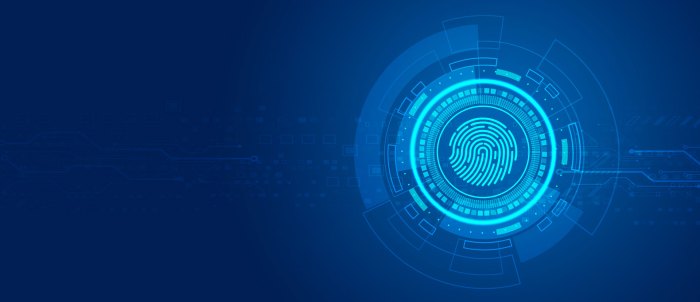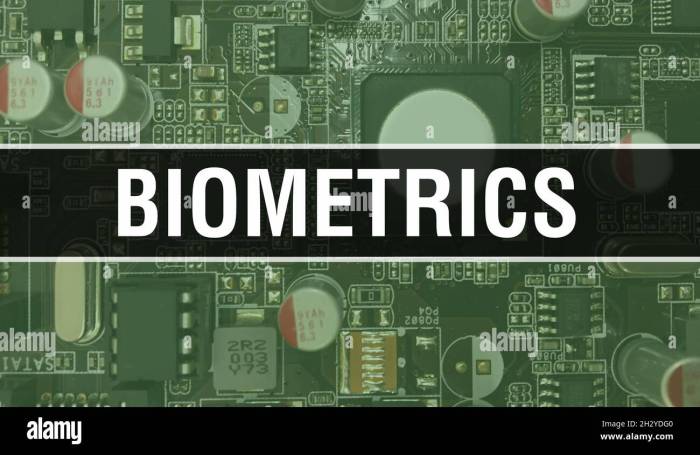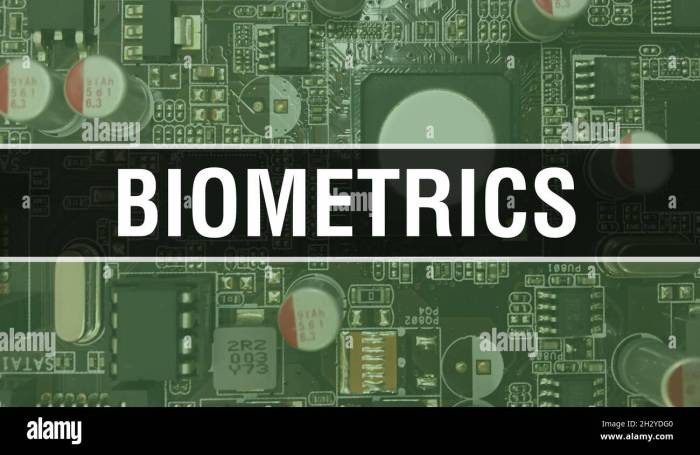Biometrics ThinkPad and Beyond A Deep Dive
Biometrics ThinkPad and beyond explores the fascinating world of biometric authentication, moving beyond the familiar ThinkPad laptops to examine its wider applications. This journey delves into the history and evolution of this technology, exploring how fingerprint, facial recognition, and iris scanning methods work. We’ll dissect how ThinkPad laptops leverage biometrics, examining security protocols and the specific technical implementations. The discussion then expands to encompass the broader implications of biometrics, showcasing applications in healthcare, finance, and security, as well as the potential for future integration.
The exploration further investigates security and privacy concerns, highlighting potential vulnerabilities and data protection regulations. User experience and accessibility are also key considerations, looking at challenges and solutions for diverse user groups. Finally, we’ll examine emerging technologies impacting biometrics, discussing future trends and potential integration with other advancements.
Introduction to Biometric Authentication

Biometric authentication, leveraging unique physical characteristics, is rapidly becoming a cornerstone of security in various sectors. From unlocking smartphones to securing sensitive government data, the technology is evolving at a remarkable pace, offering a more secure and convenient alternative to traditional passwords. This approach to verification relies on the inherent uniqueness of an individual’s characteristics, making it significantly more difficult to replicate or compromise compared to traditional methods.Biometric authentication systems are designed to verify a person’s identity by analyzing and comparing their unique physical traits against a pre-existing database.
This process involves capturing a biometric sample, processing it using algorithms, and then comparing it to the stored template to determine a match. The core principle is the uniqueness of each individual’s traits.
History and Evolution of Biometric Authentication
The concept of using biological characteristics for identification is not new. Early forms of biometric authentication, such as fingerprinting, emerged in the late 19th century. The development of digital image processing and computing power spurred the advancement of more sophisticated techniques like facial recognition and iris scanning in the 20th century. The exponential growth in computing power and sophisticated algorithms have led to a significant improvement in accuracy and efficiency of biometric authentication systems.
ThinkPad and Beyond: Expanding the Scope, Biometrics thinkpad and beyond
The integration of biometric authentication into ThinkPad laptops, and other devices beyond, signifies a broader shift towards a more secure digital landscape. This extends beyond personal devices to include enterprise-level security solutions. The ease of use and enhanced security provided by biometric authentication can be seamlessly incorporated into various applications, from access control to financial transactions, making it a crucial element in the future of digital security.
The increasing prevalence of mobile devices and the need for robust security have fueled the growth of this technology.
Comparison of Biometric Authentication Methods
Different biometric methods leverage various physical traits for identification. The choice of method depends on factors like cost, accuracy, and ease of implementation. The following table summarizes key characteristics of common biometric authentication methods:
| Method | Physical Trait | Accuracy | Security | Cost | Ease of Use |
|---|---|---|---|---|---|
| Fingerprint Scanning | Unique ridge patterns on fingertips | High | Medium | Low | High |
| Facial Recognition | Unique facial features | Medium to High (depending on lighting and resolution) | Medium | Medium | High |
| Iris Scanning | Unique patterns in the iris of the eye | Very High | Very High | High | Medium |
The table above provides a concise comparison of various biometric authentication methods. Choosing the appropriate method involves carefully considering the specific security needs and the resources available.
Biometric Authentication in ThinkPad Laptops
ThinkPad laptops have long been recognized for their robust build quality and security features. Biometric authentication is a crucial element in this security arsenal, offering a convenient and increasingly secure way to access sensitive information. This approach reduces the reliance on traditional passwords, enhancing the overall user experience and bolstering the protection of personal data.Modern ThinkPad models are integrating advanced biometric technologies, providing users with reliable and secure access to their devices.
The specific implementation varies depending on the model, but the underlying principles remain consistent: providing a secure and efficient authentication method.
Current Biometric Features
ThinkPad laptops currently offer a range of biometric authentication methods, including fingerprint scanning, facial recognition, and in some cases, even iris scanning. The availability of these features varies depending on the specific ThinkPad model. Each method offers a unique set of advantages and disadvantages, influencing the user experience and the overall security posture of the device.
Technical Implementation
The technical implementation of biometrics in ThinkPad devices involves sophisticated hardware and software integration. Fingerprint sensors are typically embedded directly into the keyboard or touchpad. Facial recognition systems rely on high-resolution cameras to capture and analyze facial features. These systems utilize algorithms for image processing and pattern recognition to identify unique characteristics. Iris scanning, when available, employs specialized cameras to capture and analyze the unique patterns of the iris.
The security protocols employed by ThinkPad devices are crucial for maintaining data integrity and preventing unauthorized access.
Security Protocols and Safeguards
ThinkPad laptops employ robust security protocols to safeguard biometric data. These protocols include encryption of biometric templates and data, ensuring that sensitive information remains confidential even if the device is compromised. Furthermore, multiple layers of authentication are often employed, such as a PIN or password in conjunction with the biometric method. These combined approaches are critical for providing comprehensive security.
For instance, a fingerprint scan might be required in conjunction with a PIN to gain full access to the system. This multi-factor authentication significantly enhances the overall security posture. Data encryption is paramount, and ThinkPad laptops leverage strong encryption algorithms to protect biometric templates and other sensitive data.
Biometrics on ThinkPads and similar devices are becoming increasingly prevalent, but we need to consider the potential for misuse. This raises concerns about security vulnerabilities, especially when considering the rising tide of online threats like spyware. The threat of spyware, which is evolving into the next generation of spam, is a serious concern for anyone using technology. Ultimately, advancements in biometrics like those on ThinkPads must be balanced with proactive measures to combat evolving threats like spyware the next spam , to ensure responsible and secure technological integration.
Comparison of Biometric Authentication Methods
| Biometric Method | Pros | Cons |
|---|---|---|
| Fingerprint Scanning | Convenient, relatively quick, often integrated into the device | Potential for spoofing, accuracy can be affected by environmental factors (moisture, dirt) |
| Facial Recognition | Convenient, user-friendly, potentially more natural than other methods | Susceptible to spoofing with high-quality images, accuracy may be affected by lighting conditions, and potentially more vulnerable to attacks from a distance. |
| Iris Scanning | High accuracy, very difficult to spoof | More complex to implement, user may need to adjust to the process, potentially less convenient |
The table above provides a comparative overview of the various biometric authentication methods offered in ThinkPad laptops. Choosing the most appropriate method depends on specific security requirements and user preferences. Each approach has its strengths and weaknesses, which need to be considered when selecting the most suitable option for a particular use case.
Beyond ThinkPad: Biometrics Thinkpad And Beyond
Biometric authentication is no longer confined to the realm of personal computing devices. Its applications are expanding rapidly across diverse sectors, from healthcare and finance to national security. This evolution reflects the increasing need for secure and reliable identification methods in a world increasingly reliant on digital interactions. This exploration delves into the wider applications of biometrics, examining its implementation in various environments and sectors.
Biometric Authentication in Other Computing Devices
Biometric authentication is increasingly integrated into a wider range of computing devices beyond laptops. Smartphones, tablets, and even wearables are adopting fingerprint sensors, facial recognition, and other biometric methods for user verification. These devices benefit from the convenience and security offered by biometrics, enhancing user experience and mitigating the risk of unauthorized access. The integration of biometrics into everyday devices reflects a trend toward more secure and user-friendly digital interactions.
Biometric Applications in Different Sectors
Biometric authentication is revolutionizing various sectors. In healthcare, it streamlines patient identification, reducing errors and improving data security. Secure access to medical records and controlled dispensing of medications are enhanced through the use of biometrics. In finance, biometrics secures transactions, preventing fraud, and ensuring compliance. Financial institutions leverage biometric authentication to verify customers and authorize payments, significantly improving security.
Similarly, biometric verification strengthens security protocols in government agencies, ensuring only authorized personnel access sensitive information.
Future Potential of Biometric Authentication
The future potential of biometric authentication is vast. As technology advances, we can anticipate more sophisticated and integrated biometric systems. The integration of biometrics with artificial intelligence (AI) could create more personalized and adaptive authentication experiences. Imagine systems that adjust authentication protocols based on individual user characteristics and environmental factors, adding another layer of security and convenience.
Comparison of Biometric Implementations Across Sectors
| Sector | Biometric Method | Application Example | Security Advantages | Challenges |
|---|---|---|---|---|
| Healthcare | Fingerprint, facial recognition | Patient identification, medication dispensing | Reduces errors, enhances security | Privacy concerns, potential for spoofing |
| Finance | Fingerprint, facial recognition, voice recognition | Transaction verification, customer authentication | Prevents fraud, enhances security | Cost of implementation, maintaining data integrity |
| Security | Facial recognition, iris scanning | Access control, surveillance | High accuracy, reliable identification | Potential for bias in algorithms, ethical concerns |
| Transportation | Facial recognition, fingerprint | Boarding verification, access control | Speeds up processes, enhances security | Privacy concerns, potential for misuse |
The table above provides a concise overview of biometric implementations across various sectors. Each sector faces unique challenges, but the overall trend points toward a future where biometric authentication becomes an integral part of our daily lives.
Security and Privacy Concerns
Biometric authentication, while offering significant security advantages, also presents unique challenges related to security and privacy. The reliance on unique physical characteristics raises concerns about potential vulnerabilities and misuse of sensitive data. Protecting this data requires a multifaceted approach that considers both technical safeguards and regulatory compliance.
Potential Security Risks and Vulnerabilities
Biometric systems are susceptible to various attacks, ranging from spoofing attempts to data breaches. Compromised or improperly secured databases containing biometric templates can be exploited by malicious actors. This can lead to unauthorized access to systems and potentially identity theft. Moreover, vulnerabilities in the authentication algorithms themselves can be exploited to bypass security measures. For instance, a sophisticated spoofing attack using a high-quality replica of a fingerprint or iris could potentially deceive the system.
Data Privacy Concerns and Regulations
Protecting the privacy of biometric data is paramount. Regulations like GDPR (General Data Protection Regulation) and CCPA (California Consumer Privacy Act) impose strict requirements for the collection, storage, and use of personal biometric data. Organizations must ensure compliance with these regulations, implementing appropriate data protection measures and obtaining informed consent from individuals before collecting and using their biometric information.
The sensitive nature of biometric data necessitates careful consideration of potential risks to prevent unauthorized access or misuse.
Methods for Mitigating Security Threats
Implementing robust security protocols is crucial for mitigating the risks associated with biometric authentication. Strong authentication mechanisms, such as multi-factor authentication (MFA) along with biometric verification, can significantly reduce the risk of unauthorized access. Regular security audits and vulnerability assessments are essential to identify and address potential weaknesses in the system. Additionally, stringent access controls and secure data storage practices are vital for protecting biometric templates.
Implementing strong encryption protocols, like Advanced Encryption Standard (AES), is also critical for safeguarding data during transmission and storage.
Table of Potential Security Breaches and Mitigation Strategies
| Potential Security Breach | Mitigation Strategy |
|---|---|
| Spoofing attacks (e.g., using a fake fingerprint) | Employing liveness detection techniques to verify the authenticity of the biometric input. This could involve analyzing the dynamic characteristics of the biometric trait, such as the vein patterns in a fingerprint. |
| Data breaches of biometric databases | Implementing strong encryption, access controls, and secure data storage practices. Employing regular security audits to identify and address potential vulnerabilities. |
| Insider threats | Strict access controls, background checks, and regular monitoring of employee activities. Implementing a robust security awareness training program. |
| Algorithmic vulnerabilities | Regularly updating and evaluating authentication algorithms to ensure their effectiveness against emerging threats. Employing independent security audits to evaluate the robustness of algorithms. |
User Experience and Accessibility

Biometric authentication, while offering enhanced security, must be thoughtfully designed to ensure seamless user experience and accessibility for all. A positive user experience is crucial for widespread adoption, encouraging users to embrace this technology rather than resisting it. This section explores the key aspects of user experience and accessibility in biometric authentication systems, focusing on the challenges and solutions for diverse user populations.A well-designed biometric authentication system prioritizes usability, making the process intuitive and efficient.
Factors such as ease of enrollment, authentication speed, and error handling directly impact user satisfaction and acceptance. The inclusion of diverse users, representing various physical and cognitive abilities, is paramount. Designing for accessibility means ensuring the system works effectively for everyone, not just a select group.
Impact of User Experience on Adoption
User experience plays a critical role in the adoption of biometric authentication. A positive experience encourages users to adopt the technology. Conversely, a frustrating or cumbersome process can lead to resistance and decreased acceptance. Factors like the speed of authentication, the ease of enrollment, and the clarity of error messages contribute significantly to user satisfaction. A smooth and intuitive experience fosters trust and reliability in the system.
Challenges for Diverse Users
Implementing biometric authentication systems requires careful consideration of the diverse needs of users. Different individuals may have varying physical abilities, such as limited dexterity or vision impairments. These factors can present challenges for enrollment and authentication processes. Furthermore, cultural or linguistic differences might also influence user interaction.
Usability in Biometric Systems
Usability is fundamental to the success of biometric authentication systems. An intuitive and user-friendly interface significantly impacts the adoption rate. Well-structured enrollment procedures and clear instructions for authentication are essential for a positive experience. Providing clear feedback, especially during authentication attempts, is crucial. Detailed error messages, accompanied by appropriate guidance, can help users troubleshoot issues and maintain confidence in the system.
User Accessibility and Inclusivity
User accessibility and inclusivity are paramount in designing effective biometric systems. This entails considering diverse user needs and ensuring the system is usable by people with various disabilities. Features like adjustable font sizes, alternative input methods, and clear audio cues enhance accessibility for users with visual or auditory impairments. Designing for inclusivity extends beyond accommodating disabilities to also include diverse cultural backgrounds and linguistic preferences.
Biometrics on ThinkPads and similar devices are raising interesting questions about security. Beyond the convenience of fingerprint logins, the potential for misuse by governments is a significant concern. For example, understanding how government oversight impacts the security and privacy of VoIP communications is crucial, as detailed in this excellent resource on government oversight and protecting VoIP.
Ultimately, the future of biometric devices like those found on ThinkPads depends heavily on responsible development and use, ensuring user privacy is paramount.
Examples of Biometric Systems and User Experience
Different biometric authentication systems offer varying user experiences. Facial recognition systems, for example, often rely on clear images and minimal user interaction. Fingerprint scanners, on the other hand, typically require a physical touch, impacting users with certain dexterity challenges. Voice recognition systems can be affected by environmental noise and user speech patterns. The user experience is directly linked to the specific biometric technology used.
To improve usability, systems can employ multiple authentication factors (multi-factor authentication) and offer alternative authentication methods for specific users. This ensures a more inclusive and reliable user experience.
Addressing User Experience Concerns
User experience issues in biometric authentication systems can be addressed by adopting user-centered design principles. Thorough user testing and feedback collection during development can identify potential problems and inform design improvements. Systems should be flexible and adaptable to different user needs and preferences. Furthermore, clear communication regarding system limitations and potential error scenarios is vital.
Technological Advancements and Future Trends
Biometric authentication is rapidly evolving, driven by advancements in sensor technology, artificial intelligence, and data security. This evolution promises to make authentication more secure, convenient, and accessible, but also raises important considerations regarding privacy and user experience. Understanding these trends is crucial for anticipating future challenges and opportunities in this field.Emerging technologies are reshaping the landscape of biometric authentication, pushing the boundaries of what’s possible.
This transformation includes the integration of innovative technologies, leading to more accurate, reliable, and efficient authentication systems. These advancements will profoundly impact various sectors, from personal devices to high-security environments.
Emerging Technologies Impacting Biometric Authentication
Biometric authentication is being enhanced by several emerging technologies. These include improvements in existing methods, like fingerprint scanning, and the introduction of entirely new modalities. For instance, liveness detection is becoming more sophisticated, making it harder to spoof biometric systems with counterfeit materials.
- Improved Sensor Technology: Advanced sensors, including those utilizing optical, ultrasonic, and thermal imaging, are enabling more accurate and reliable biometric data capture. This enhanced precision reduces the risk of false acceptances or rejections. For example, high-resolution fingerprint sensors are now capable of capturing more detailed patterns, leading to a greater level of security and usability.
- Artificial Intelligence (AI) Integration: AI algorithms are being increasingly used to analyze biometric data, improving accuracy and speed. Machine learning models can identify subtle patterns and anomalies, significantly enhancing the robustness of authentication systems. For example, AI can analyze subtle changes in facial expressions to verify a user’s identity, making it more difficult to spoof biometric authentication.
- Liveness Detection: Sophisticated liveness detection techniques are becoming essential components of biometric systems. These techniques verify that the biometric sample is from a live person, reducing the risk of fraud and enhancing security. For example, dynamic liveness detection methods assess the movement of facial muscles, making it difficult to replicate with a static image.
Future Direction of Biometric Authentication
The future of biometric authentication is likely to be characterized by a shift towards more multimodal approaches. Instead of relying on a single biometric trait, systems will combine multiple modalities to achieve higher accuracy and security. For instance, a system might integrate fingerprint scanning with facial recognition for a more robust authentication process.
Biometrics on ThinkPads and beyond are getting increasingly sophisticated, but reliable wireless connectivity is key. The recent moves by the Wifi Alliance to harden interoperability standards, as detailed in this article , are crucial for seamless performance in these increasingly integrated systems. Ultimately, secure and consistent wireless connections are essential for the future of biometric devices like those found on ThinkPads and other laptops.
- Multimodal Biometrics: Combining multiple biometric traits (e.g., fingerprint, facial recognition, iris scan) will enhance the security and reliability of authentication systems. This approach reduces the risk of spoofing by requiring multiple verification methods.
- Context-Aware Authentication: Authentication systems will increasingly consider contextual factors, such as location, time, and device, to further enhance security. For example, an access control system might require a specific device to be used at a particular location to verify the user’s identity. This significantly reduces the risk of unauthorized access.
- Cloud-Based Biometric Systems: Cloud-based biometric systems offer scalability and convenience, allowing users to access their biometric data from various devices. However, this approach necessitates robust data security protocols to safeguard sensitive information.
Integration with Emerging Technologies
Biometric authentication is poised to integrate with other emerging technologies, creating more seamless and intelligent user experiences. This integration is likely to encompass areas such as augmented reality, the Internet of Things (IoT), and wearable technology.
- Augmented Reality (AR): AR overlays could enhance biometric authentication processes, guiding users through procedures and providing feedback. For instance, an AR interface could provide visual cues or instructions during a facial recognition scan, making the process more intuitive and user-friendly.
- Internet of Things (IoT): Biometric authentication will play a crucial role in securing IoT devices, preventing unauthorized access to sensitive data and services. For example, smart homes will use biometric authentication to control access to rooms and appliances.
- Wearable Technology: Wearable biometric authentication systems could offer a convenient and secure way to access personal devices and services. For instance, a smartwatch equipped with biometric sensors could verify user identity to unlock a smartphone or grant access to financial applications.
Comparison of Biometric Systems
| Biometric System | Accuracy | Security | Cost | Accessibility |
|---|---|---|---|---|
| Fingerprint Scanning | High | Medium | Low | High |
| Facial Recognition | Medium | High | Medium | High |
| Iris Scanning | Very High | Very High | High | Medium |
| Voice Recognition | Medium | Medium | Low | High |
Case Studies and Examples
Biometric authentication, once a futuristic concept, is now a tangible reality in numerous sectors. Real-world deployments demonstrate its effectiveness and adaptability, offering valuable insights into its impact on user experience, security, and business operations. From high-security government facilities to everyday consumer applications, biometric solutions are evolving and improving. This section delves into compelling case studies showcasing the successful implementation of biometric authentication.
Financial Sector Deployments
Biometric authentication is increasingly popular in the financial sector, enhancing security and user experience. These solutions often integrate fingerprint scanning, facial recognition, or even voice recognition to verify customer identities during transactions. The enhanced security measures reduce fraud, while the user experience, with quick and convenient access, is a significant benefit.
- Bank A: A large bank implemented fingerprint scanning for customer logins. This improved security by significantly reducing fraudulent access attempts and increased customer satisfaction by streamlining the login process. The reduction in fraud led to substantial cost savings for the bank.
- Investment Firm B: Facial recognition was used for employee access control. This system streamlined the daily security process, eliminating the need for physical keys or keycards. Improved security and reduced administrative burden for the firm.
Government and Public Sector Implementations
The public sector is also increasingly embracing biometric authentication for enhanced security and efficiency. Government agencies use biometrics to verify the identities of citizens, protect sensitive information, and ensure accountability. Biometric access control in government buildings and sensitive facilities helps to safeguard critical infrastructure.
- Department of Defense (DoD): In some areas, the DoD is experimenting with iris scanning for high-security access to sensitive military installations. This system significantly reduces the risk of unauthorized personnel gaining access to classified information.
- National Parks Service: Several parks have implemented biometric entry systems to control visitor numbers and access to popular areas. This method ensures proper management of visitor traffic while simultaneously improving security.
Healthcare Sector Use Cases
In healthcare, biometric authentication ensures patient verification and access control. Hospitals and clinics are adopting these solutions to verify patients’ identities, improve security, and streamline workflows.
- Hospital X: This hospital implemented facial recognition for patient check-in and access to medical records. This system reduced errors in patient identification and streamlined the patient intake process. The system is also being used for tracking and controlling the flow of staff and patients.
A Detailed Case Study: Biometric Access Control at a Research Facility
“The National Institute of Health’s (NIH) research facility implemented a multi-factor biometric system for enhanced security. Facial recognition was combined with a PIN code for access control. This approach significantly reduced the risk of unauthorized access to sensitive research materials and intellectual property. The deployment demonstrated that combining multiple biometric methods provides a more secure solution than relying on a single factor, as it mitigates the risks of spoofing and errors. The facility saw a 95% reduction in unauthorized access attempts within the first year of implementation.”
Ending Remarks
In conclusion, biometrics ThinkPad and beyond offers a comprehensive overview of this rapidly evolving technology. From the specifics of implementation in ThinkPad laptops to broader applications across various sectors, we’ve covered a wide range of considerations. The discussion highlights the increasing importance of biometric security, the challenges of maintaining privacy, and the crucial role of user experience in its successful adoption.
As technology advances, the future of biometrics promises exciting developments and applications across multiple industries.







